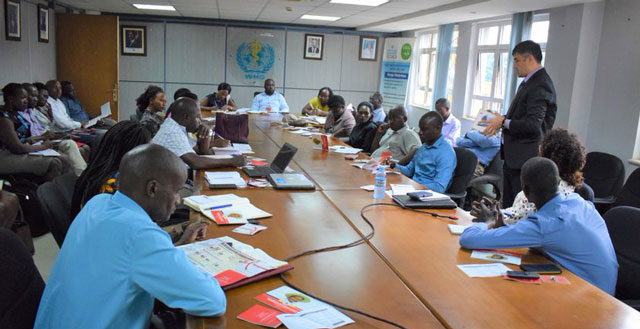
Kampala, Uganda | THE INDEPENDENT | Only 48 per cent of young people have comprehensive knowledge about how HIV is spread and how they can guard against it, according to data shared by the Joint United Nations Programme on HIV/AIDS (UNAIDS) Uganda, this afternoon.
For one to have comprehensive knowledge about HIV, they should be able to identify that using condoms consistently and limiting sex to one uninfected partner are two ways of preventing transition. They should also be able to reject common misconceptions that mosquitoes transmit HIV, that sharing food with an infected person transmits infection and knowing that a healthy-looking person can transmit the virus.
Dr Karusa Kiragu, the UNAIDS Country Director in Uganda told journalists in Kampala that while there are high infection rates among young people at 18,500 of the 53,000 new infections recorded last year, they still score very low on the five questions that entail having comprehensive knowledge about HIV.
Karusa was delivering the HIV AIDS country update ahead of the December 1, World AIDs day which is this year being marked under the theme ‘Communities make a difference’.
She said that even if the government comes up with numerous campaigns and platforms for HIV prevention without putting in place avenues that ensure that those messages reach the targeted audience without distortion, not much will be gained from those campaigns.
Karusa says that the government should now be looking for new ways of getting to young people and the 52 per cent who remain ignorant about basic issues, especially with the way response to HIV, have been quickly changing, from testing to treatment.
On his part, Komiljon Akhmedov, a Fast Track Adviser at UNAIDS said that to target the youth, the country needs to borrow ideas from the Presidential Fast Track Initiative on ending HIV/AIDS which was launched in June 2017 to among others ensure that more men get tested and treated for HIV which two years later is proving to be paying off.
Today, @UNAIDS hosted the press to discuss HIV/AIDS statistics. This is a deliberate effort to partner with the media in mobilising communities to #EndAIDS2030. @UNAIDS_ESA @newvisionwire @DailyMonitor @UGIndependent @KarusaKiragu @ntvuganda @nbstv @KarusaKiragu @aidscommission pic.twitter.com/tSrkZrruzI
— UNAIDS Uganda (@UNAIDS_UG) October 14, 2019
For instance, when it comes to enrolling on treatment, he says more males are getting treated from 316,000 in 2017 to 410,000 by the end of 2018.
He also notes that with the initiative in place and the president’s involvement in the response, drug stock-outs which characterized most of the year reduced from 46 per cent of health facilities reporting this by end of 2016 to 20 per cent by end of 2018.
Overall, he said measuring by the UNAIDS 90-90-90 when it comes to men 84 per cent currently know their status, 63 per cent of the positive are enrolled on treatment and 55 per cent are virally suppressed. The UN targets to ensure that by 2020, 90 per cent of people know their status, 90 per cent of those who test positive enrol on treatment and 90 per cent of those on treatment are virally suppressed.
Even with these figures, however, Karusa says 1,000 people still get infected in Uganda every week.
*****
URN
 The Independent Uganda: You get the Truth we Pay the Price
The Independent Uganda: You get the Truth we Pay the Price



